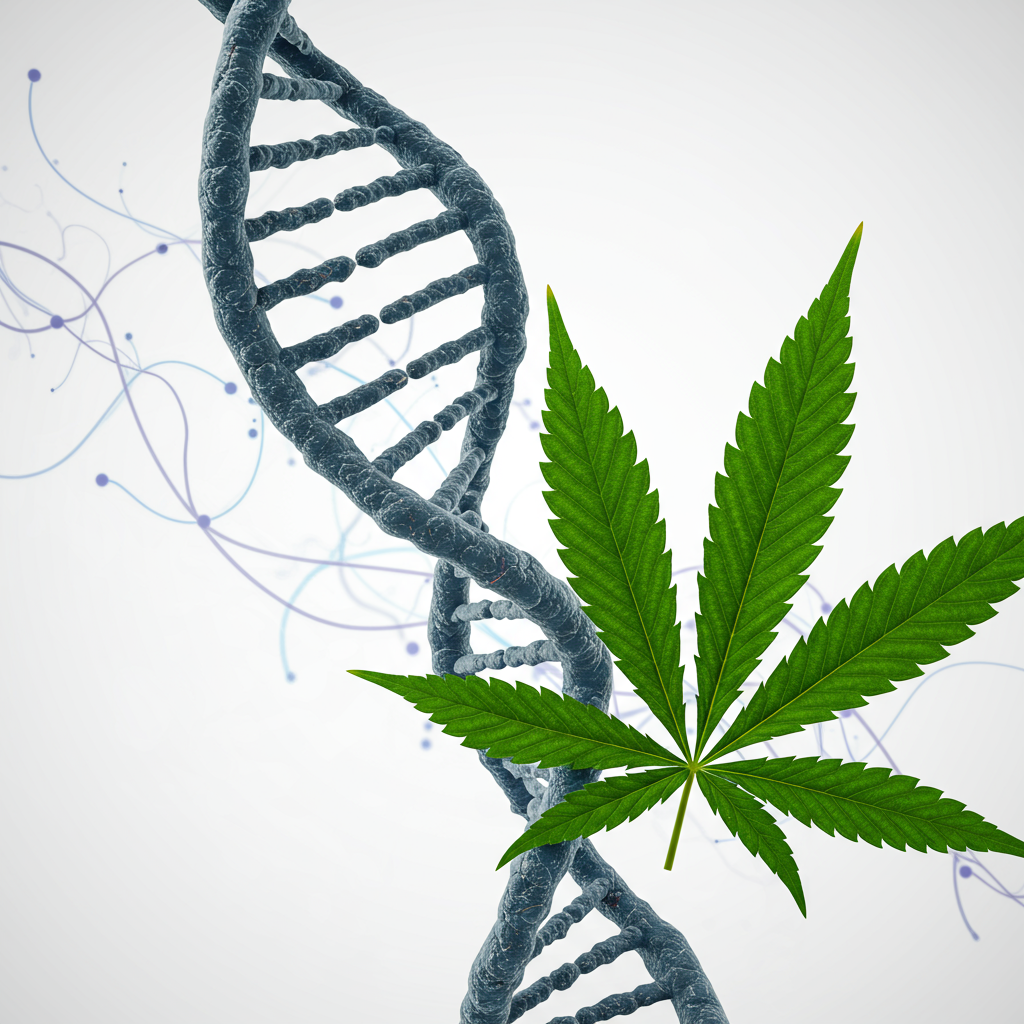The relationship many people have with cannabis is often seen as a matter of personal choice or environmental influence. However, groundbreaking scientific research is now revealing a deeper connection: your genetic code. A recent, extensive study, along with other significant findings, suggests that specific genes can play a crucial role in determining not only whether you try cannabis but also how your body and brain react to it, influencing everything from frequency of use to susceptibility to addiction and long-term health impacts. This evolving understanding of DNA and cannabis use is fundamentally changing how we view prevention, intervention, and the potential risks associated with this widely used substance.
Decoding the Genetic Blueprint of Cannabis Use
Groundbreaking Research Uncovers Key Genes
A landmark study, a collaborative effort between the University of California, San Diego, and the DNA testing service 23andMe, has provided compelling evidence for the genetic underpinnings of cannabis behaviors. Published in Molecular Psychiatry, this research analyzed genetic and self-reported cannabis use data from over 130,000 participants, making it one of the largest investigations of its kind.
Dr. Sandra Sanchez-Roige, an associate professor of psychiatry at UC San Diego and the lead researcher, highlighted the importance of this work, noting that despite widespread cannabis use, its long-term health effects remain poorly characterized. The study employed a genome-wide association study (GWAS) to pinpoint genetic factors. Researchers identified two primary genetic players strongly linked to cannabis use:
Cell Adhesion Molecule 2 (CADM2): This gene is vital for brain cell communication. Prior research has connected CADM2 to traits like impulsivity, obesity, and an increased risk of certain cancers.
Metabotropic Glutamate Receptor 3 (GRM3): Known for its influence on brain plasticity, GRM3 has established associations with severe psychiatric conditions, including schizophrenia and bipolar disorder.
Beyond these two major genes, the team identified 40 additional genes tied to lifetime cannabis use and four linked to the frequency of use. Notably, 29 of these genes were entirely new discoveries in cannabis research, underscoring the novel insights this study offers.
Beyond Use: Genetic Ties to Mental and Physical Health
The findings became even more striking when researchers compared these cannabis-related genetic associations with data from two major US health databases. A significant overlap emerged, indicating that these genes are not isolated but are associated with over 100 other traits and conditions.
These include a range of mental and cognitive traits such as:
Attention-deficit/hyperactivity disorder (ADHD)
Anxiety
Depression
Risky behaviors
Furthermore, genetic correlations extended to various physical conditions:
Diabetes
Chronic pain
Increased risk of tobacco use
Autoimmune disorders
Infectious diseases like HIV and hepatitis
Crucially, the study emphasizes that while specific genes may increase an individual’s susceptibility to cannabis use or related disorders, they are not sole determinants. Environmental factors, lifestyle choices, and personal decisions continue to play significant roles. Dr. Hayley Thorpe, a postdoctoral researcher and co-author, noted that studying these intermediate traits can help researchers map how genetic risk unfolds before cannabis use disorder develops.
Deeper Dive: How Cannabis Interacts with Your DNA
Cannabis and Epigenetics: A Lasting Imprint
Beyond direct genetic predisposition, cannabis use appears to leave a footprint on our DNA through epigenetic mechanisms. A two-decade study involving over 1,000 U.S. adults, led by epidemiologist Lifang Hou from Northwestern University, explored these profound interactions. Published in Molecular Psychiatry, this research focused on DNA methylation, a chemical modification that can alter how genes function without changing the underlying genetic code.
The study revealed “associations between cumulative marijuana use and multiple epigenetic markers across time.” These changes were evident in individuals reporting both short-term and long-term cannabis use. Environmental factors like diet and toxins are known to impact these markers, and now cannabis use can be added to the list. One particularly striking discovery was a consistent methylation marker already known to be linked to tobacco use, suggesting a similar biological response to both substances or a common impact from smoke exposure. The number of methylation markers associated with cannabis use increased significantly over time, from 53 markers at year 15 to 148 markers at year 20, suggesting that epigenetic effects may accumulate with continued use.
The Genotoxic Truth: DNA Damage and Health Risks
Further adding to the complexity, a scientific paper published in Addiction Biology* asserts that marijuana is a “genotoxic” substance. This means it actively damages the genetic information within cells, potentially leading to DNA mutations, accelerated biological aging, and an increased risk of cancer.
Study co-author Stuart Reece of the University of Western Australia highlights a critical and novel finding: this genetic damage can be inherited. He states that the genotoxicity from cannabis use can be transmitted to offspring through affected egg and sperm cells, thereby extending potential risks to future generations. Reece’s research connects this cellular damage to mitochondrial dysfunction, where cannabinoids reduce the energy production capabilities of these vital cell structures. This dysfunction, in turn, can drive chromosomal damage.
The paper also addresses the long-debated “cancer-cannabis link,” noting that cannabis has been associated with an increased risk of testicular cancer. Reece clarifies that past controversies might be due to study design limitations and a significant increase in cannabis potency since the 1970s. While cancer might be a less frequent outcome, accelerated biological aging is a more commonly observed effect, with one report indicating “a dramatic acceleration of [biological] age by 30% at just 30 years” in individuals with cannabis exposure. The exact amount of cannabis needed to cause lasting damage, however, remains to be precisely defined.
Understanding Risk and Implications
Identifying Vulnerability: From First Try to Disorder
The insights gained from genetic and epigenetic research are particularly vital for understanding cannabis use disorder (CUD). Dr. Sanchez-Roige noted that nearly 30 percent of individuals who try cannabis will go on to develop CUD. Understanding the genetics of early-stage behaviors can help clarify who is at greater risk, paving the way for more effective prevention and intervention strategies. The overarching goal is to uncover genetic pathways that could lead to targeted treatments and preventive efforts for cannabis addiction. Dr. Thorpe aptly described cannabis use as existing “on a continuum,” emphasizing the broad spectrum of engagement that this research aims to better comprehend.
Global Trends and Future Directions
These findings arrive amid a global surge in cannabis consumption. In Europe, approximately 8.4 percent of adults aged 15 to 64 reported using cannabis in the past year, totaling about 24 million people, with 1.5 percent being daily or near-daily users. Globally, the World Health Organization (WHO) estimates that around 147 million people, or 2.5 percent of the population, use cannabis. The rising rates underscore the urgent need for a deeper understanding of its long-term health implications, especially as cannabis products grow in potency and accessibility. The hope is that by identifying genetic pathways, researchers can develop more personalized and effective treatments and preventive measures.
What This Means for You: Genes, Choices, and Cannabis
The emerging picture of DNA and cannabis use is complex, yet highly informative. While your genes may predispose you to certain reactions or risks, they do not seal your fate. Environmental factors, lifestyle choices, and personal decisions remain powerful determinants in your relationship with cannabis. This research empowers individuals to make more informed choices, perhaps prompting conversations with healthcare providers about family history or personal risk factors related to substance use and mental health. The field of personalized medicine, leveraging genetic insights, holds immense promise for developing tailored prevention and treatment approaches in the years to come.
Frequently Asked Questions
How does my DNA influence my risk of cannabis use disorder?
Your DNA can significantly influence your susceptibility to cannabis use disorder (CUD) by affecting how your brain processes and responds to cannabis. Studies, like the one from UC San Diego and 23andMe, have identified specific genes (e.g., CADM2, GRM3) that impact brain cell communication and plasticity. These genes can increase your likelihood of trying cannabis, using it frequently, and developing addiction. While genetic predisposition plays a role, environmental factors, lifestyle, and personal choices also remain critical in determining whether CUD develops.
What specific genes have been linked to cannabis use and addiction?
Two major genetic players identified in prominent research are Cell Adhesion Molecule 2 (CADM2) and Metabotropic Glutamate Receptor 3 (GRM3). CADM2, important for brain cell communication, has been linked to impulsivity and other traits. GRM3, which influences brain plasticity, is associated with psychiatric conditions like schizophrenia and bipolar disorder. Researchers also found 40 additional genes connected to lifetime cannabis use and four related to usage frequency, with many being newly discovered in this context. These genes overlap with those linked to over 100 other traits, including ADHD, anxiety, depression, and various physical conditions.
Can cannabis use permanently alter my DNA, and are these changes heritable?
Recent research suggests that cannabis use can indeed alter your DNA through epigenetic modifications, specifically DNA methylation. These changes affect how genes are expressed without altering the underlying genetic code. Studies show cumulative cannabis use is associated with an increasing number of these markers over time, some of which are linked to serious conditions like schizophrenia and bipolar disorder. Furthermore, new research indicates that cannabis is “genotoxic,” meaning it can directly damage genetic information, potentially accelerating biological aging and increasing cancer risk. Critically, some scientists assert that this genetic damage could be transmitted to offspring through affected egg and sperm cells, making these changes potentially heritable.
Conclusion
The growing body of research firmly establishes that your DNA holds profound clues to your individual relationship with cannabis. From genetic predispositions that influence your likelihood of use and addiction to the epigenetic marks and genotoxic damage that can accrue over time, the science points to a far more intricate connection than previously understood. This knowledge empowers us to move beyond generalized assumptions and towards a more nuanced, personalized approach to understanding cannabis use, risk, and health outcomes. As global cannabis use continues to rise, sustained research into these genetic and epigenetic pathways will be crucial for developing targeted prevention strategies, effective treatments, and fostering truly informed public health dialogues for current and future generations.




